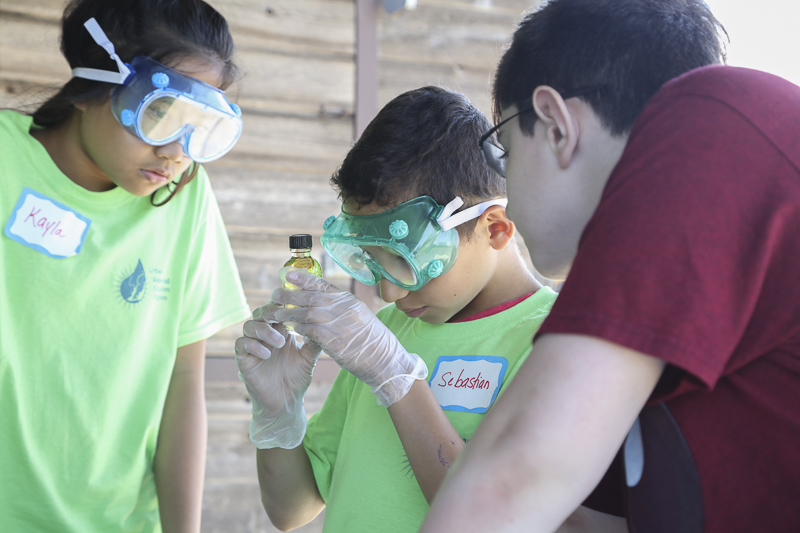|
|
Bureau of Environmental Analysis, Restoration and Standards

Watershed Education & Urban Fishing Program
Environmental Stewardship through Urban Fishing
Program Outline

|
|
Celebrating its 21st year, the Watershed Education and Urban Fishing Program (Program)
is designed to educate children from urban areas in New Jersey about their local watershed. Children learn about how people’s
actions, including their own, can affect both the water and the creatures that depend on it, as well as human health. The Program also teaches children what they can do to help protect their water resources.
For the first several years, the Program remained as a one-day fishing excursion conducted only in the Newark Bay Complex. Since then, the content has expanded to a three-day program that includes classroom, storm drain stamping/cleanup, fishing and boating activities. The Program is now also offered in other urban areas around the State, including Trenton and Camden.
|
|
Photo Credit: Hackensack Riverkeeper
|
Click on the blue bars below for details.
Program Objectives:
Upon completion of our program, students should understand:
- The function and value of an estuary as it concerns animals, plants & people
- The link between pollution, habitat contamination, contaminated fish & human health
- The need to engage in non-point source pollution prevention
- The geography of their community, focusing on where students live in relation to the estuary
- The link between human activity on the land and water quality
- The link between human actions and global warming
- The concept of watershed, bioaccumulation and food chains
- The health risks associated with the consumption of fish contaminated with dioxin and PCBs
- Name the species of fish included in their local fish consumption advisory list
- Where the waters listed in the advisories are located
- Who is most affected by consuming contaminated fish
- Where they can fish in the community
- The recreational and economic value of their water resources
- That they can be active in protecting and restoring their water resources
|
Day one takes place in a classroom setting. There are a variety of topics covered including: the identification of local waterways, the role of estuaries, bioaccumulation, how a watershed works, and identification of the species listed in the NJDEP Fish Consumption Advisory.
Students learn about the firsh on local advisories through a game called Guess Who? This leads to discussions about food chains, bioaccumulation, and the likely health effects from consuming contaminated fish and crabs.
|
|

|
|
|
|
Photo Credit: Hackensack Riverkeeper
|
Students learn the concept of nonpoint source pollution and engage in hands-on activities that demonstrate
how they can reduce and prevent water pollution. The Enviroscape, a 3-D watershed model, is utilized to
show students how land pollution becomes water pollution.
Students are exposed to global issues like climate change and greenhouse gasses. They learn how sea level
rise will affect New Jersey's coastlines. We utilize a game called Energize Me that teaches students about
the common connection between their energy use and global warming.
 |
|
Students are introduced to their local water through an Eco-Tour conducted by Hackensack Riverkeeper. Here they see how man and nature co-exist in an urban waterway. For many students, this is their first time on a boat.
After their Eco-Cruise, students test their local water for dissolved oxygen, salinity, nitrates, phosphates, pH, turbidity, and temperature. They compare results and check the levels to see if they are conducive to sustain aquatic life.
|
|
Photo Credit: Hackensack Riverkeeper
|
 |
|
On the final day, students learn how to be responsible anglers and practice "catch and release" fishing. Students travel to a place in their community where they are able to fish and hopefully encounter the types of fish that they learned about in the classroom. After fishing, students observe a fish dissection. This gives students an opportunity to view fish anatomy up close. Comparisons between fish anatomy and other animals are discussed.
|
|
|
Photo Credit: Hackensack Riverkeeper
|

|
|
Students are given a pre- and post-survey in our program to help us determine the extent that students are learning and retaining the concepts presented. These results help us to improve the program's presentations. The sruvey's 21 questions range from queries on environmental hazards, fish species found in local waters, as well as concepts like what a watershed is and what water qualities are needed to sustain life in an estuarine environment. The questions are both open ended (example: What is the name of the closest river to where you live?) and multiple choice (example: Which fish are listed in the Fish Consumption Advisory Booklet). |
|
Photo Credit: Hackensack Riverkeeper
|
|
 |
 |
 |
| Photo Credit: Hackensack Riverkeeper |
Photo Credit: Hackensack Riverkeeper |
Photo Credit: Hackensack Riverkeeper |
|
| |
|
For more information, please contact Kimberly Cenno, Bureau Chief,
Bureau of Environmental Analysis, Restoration and Standards at (609) 633-1441. |